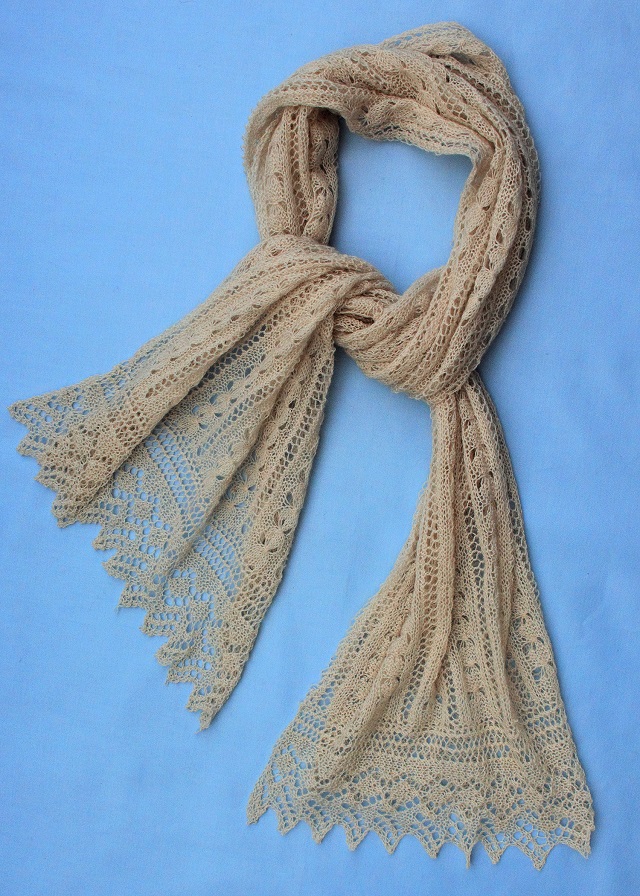Making a shawl by Judith Morley
Photographs courtesy of Elisabeth Wilkinson
The yarn
My friend Jane gave me a skein of beautiful yarn, a cashmere and silk mix in a natural deep cream colour. It weighed 66 grams and could be classed as “lace weight”. The pattern that came with it was uninspiring – a short repeat of stitches and rows, not worthy of the yarn. I had no further information.

Working out how much
I started by measuring the length of the skein. I pulled out part of the skein weighing 11g, measured as well as I could the circumference of the skein, counted the number of threads, and then multiplied up to arrive at a very rough estimate of the total length. (By the way, messing about with the skein like that was not a good idea. I had muddled the threads dreadfully and it took me hours to wind into three large and two small balls. There must be a better way).

Choosing a pattern
I consulted the lovely book of “Victorian Lace” by Jane Sowerby, which gives yardages for each design, as well as yarn weight. I was able to pick out a number of designs for which I probably had enough yarn. However, there was no complete design that I wanted to make. I needed a pattern without too many rows, as I did not want to waste yarn by finding myself finishing in the middle of a repeat and having to unpick. My favourite element was the “melon” stitch design, which gives a mock cable effect on a stocking stitch base. Melon stitch is worked over six stitches and six rows. The first four rows are stocking stitch, the fifth row is worked on the right side by slipping the six stitches onto the right hand needle. Then stitches one, two and three, are lifted, one by one, over the other three stitches. The unknitted three stitches are slipped back onto the left hand needle and worked:- “yo, k2, yo, k1, yo”. The last of the six row pattern is a purl one.
I set my pattern up in vertical stripes of six stitch panels of melon stitch alternating with four stitch, garter based panels of “K2, yo, K2tog”, which gives an effect like the needlework stitch, “faggotting”. I started each row with a very simple lacy stitch, a two stitch pattern of “yo, K2tog” which gives a fine loopy edge. At the end of each row these extra border stitches were knitted.

Work in progress
I made a temporary crochet cast on in a different coloured yarn, and set off. I had no idea how long the shawl would be, but knew I wanted to have a deep lace edging at each end worked “sideways”. When I had worked most of the three large balls of yarn, I paused and worked the beginning edge. I weighed the first small ball of yarn before I started, and used an edging pattern made on a garter stitch base that is part of a baby’s shawl pattern which I have made many times. I am always keen to use techniques which cut out sewing up and this edging is ideal, leaving the join not only invisible but also elastic. I worked it along the short side of the shawl. Every other row, when the edging knitting reaches the main part of the shawl, the last stitch of the edging is knitted together with the next one from the main shawl. I weighed off enough yarn to make the second edging to work the edging at the far end of the shawl and worked the rest into the main body.
I am delighted to say that I had a very tiny ball of yarn left over to put back into the stash.

